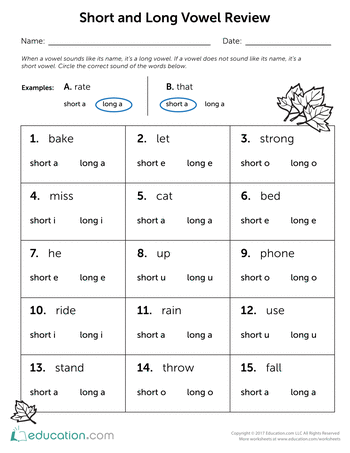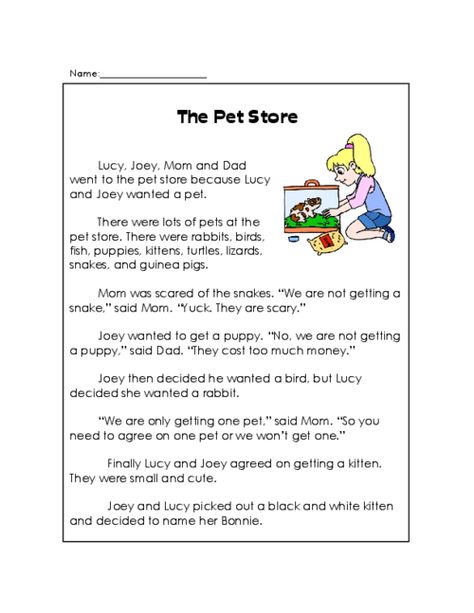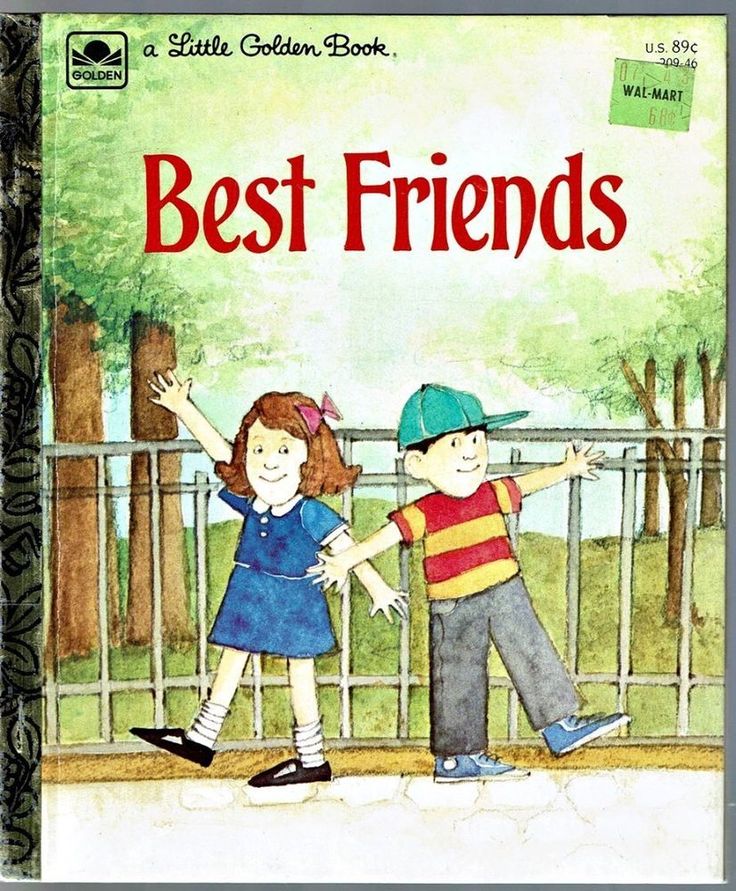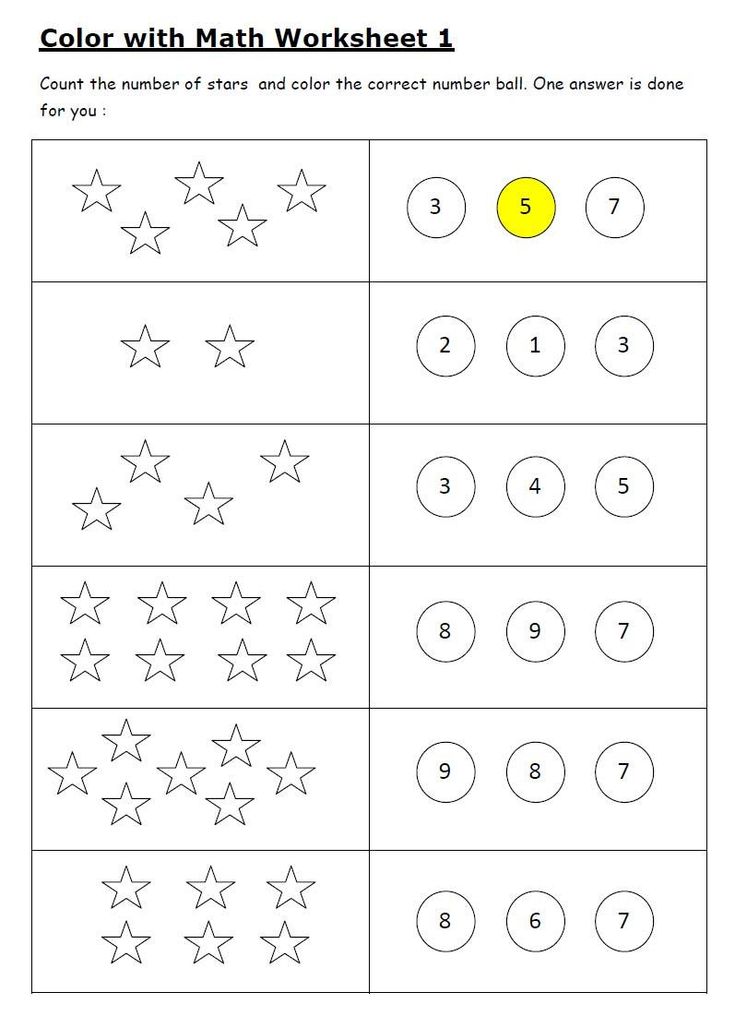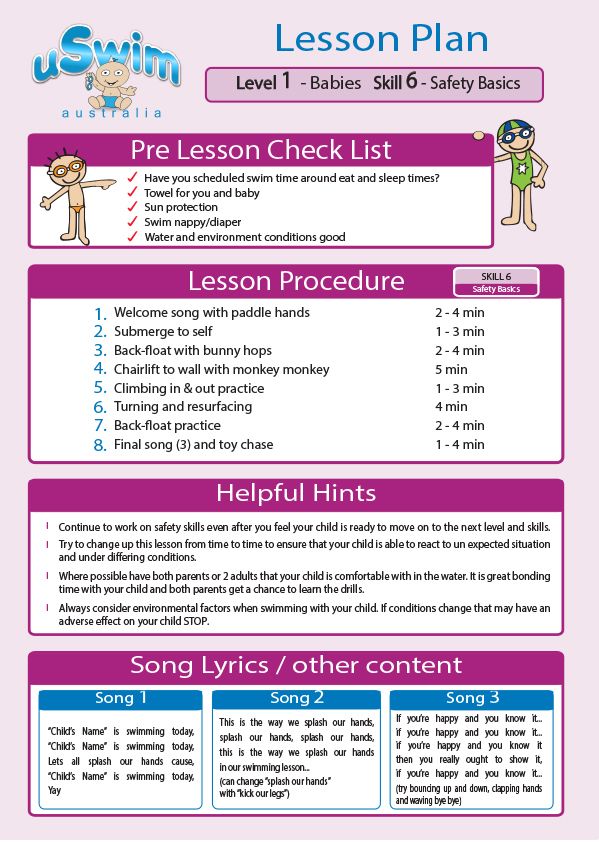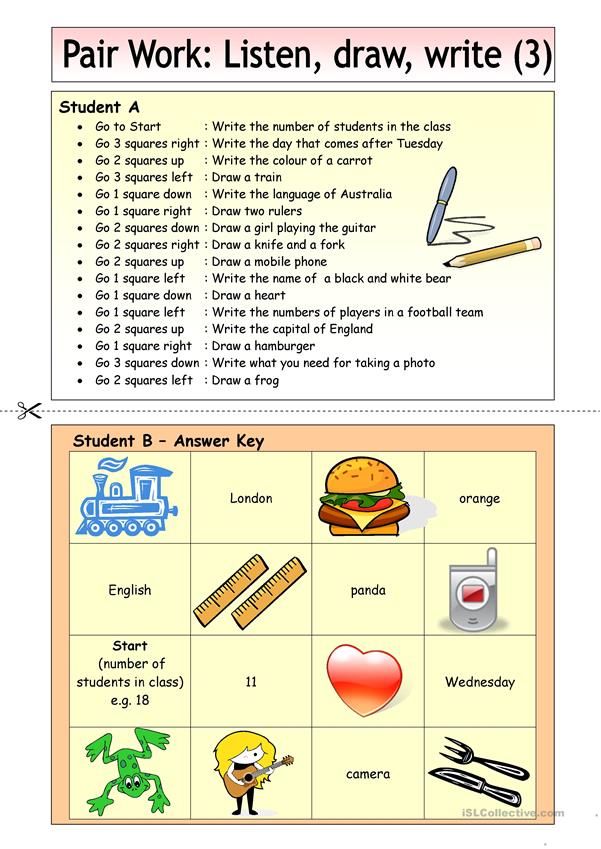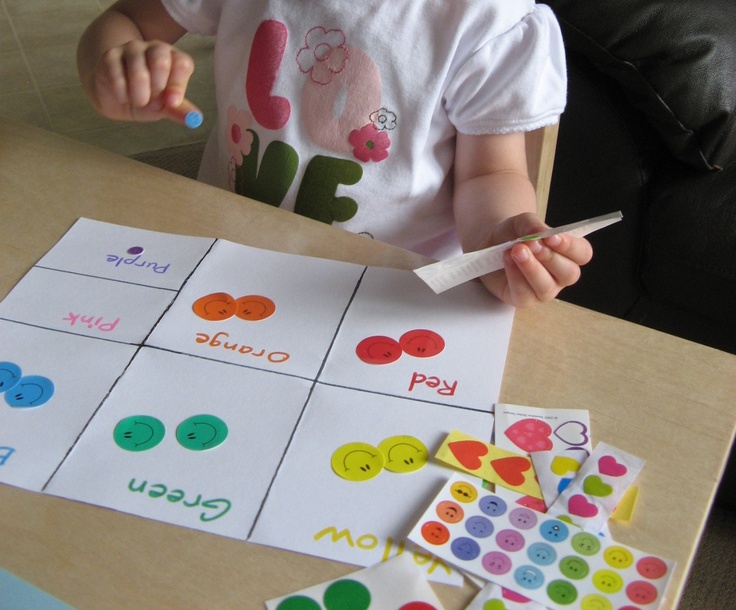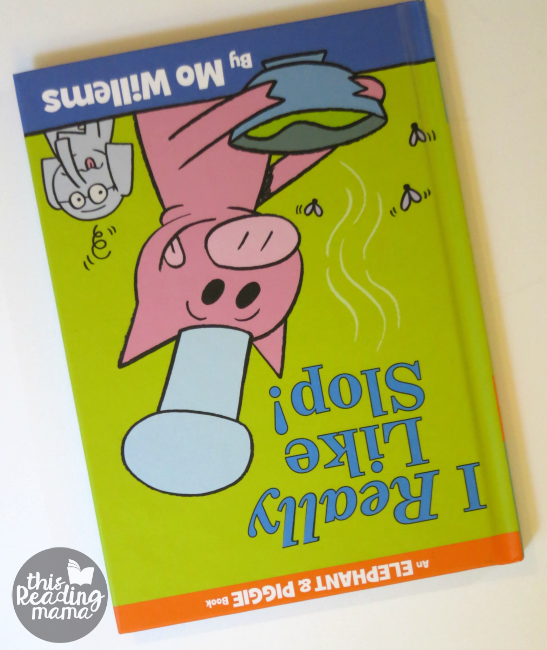When is a vowel long or short
All About Short and Long Vowel Sounds for Preschoolers
Have you ever wondered or been asked by your child why ‘a’ in ‘cat’ and ‘cake’ sound different? Or why words like ‘cub’ and ‘cube’ are pronounced differently though their spellings are almost similar? Well, you are not alone!
The sounds of the letters of the English alphabet can vary quite a bit. In some cases, it can get tricky. Not all letters make the same sound in all words. Teaching preschoolers to read English can be challenging as the letters can make different sounds depending on how they are used. A case in point is the short and long vowel sounds for preschoolers. Read on to find out how your child can learn vowel sounds and recognize their differences.
Learning short and long vowel sounds- what are they?
Learning phonics sounds is getting to know all about all vowel and consonant sounds that make up the 26 letters of the English alphabet. Each of the 5 vowels (a, e, i, o, u) can make at least 2 sounds. For example, the vowel ‘a’ sounds different in ‘cat’ and ‘cake’. How we spell with vowels does not always determine the sound it makes.
Each vowel makes two sounds- a short sound and a long sound. In some cases, they can be silent too! When a vowel makes the sound of a particular letter, then it is a short sound. However, when the vowel sounds like the letter’s name, then it makes a long sound. The sound the vowel makes depends on its position in the word and the letters that surround it.
For example:- the ‘a’ in ‘fat’ and ‘e’ in ‘bed’ make short vowel sounds. While in ‘fate’ and ‘wheat’ they make the long vowel sounds.
So, based on where and the vowel is placed in a word, its length and sound can change. When teaching preschoolers to read, you must help them understand the rules for what sound the vowels make in different instances. Yes, short and long vowel sounds for kids can be confusing at times. However, regular practice with them to recognize the distinctions will help.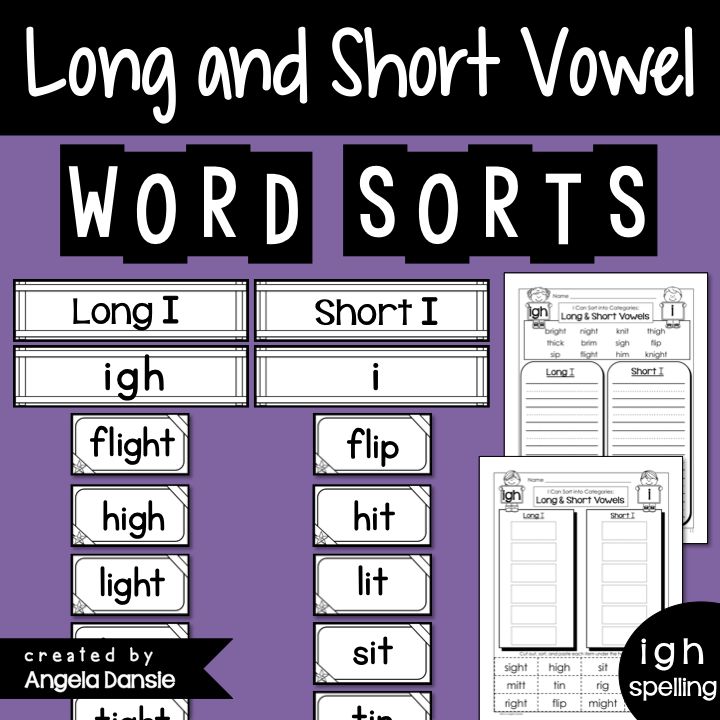
Rules to bear in mind while learning short and long vowel sounds
Here are some basic rules to help you introduce short and long vowel words for preschoolers. Do remember that rules have exceptions too.
Rule No.
Vowel Position
Vowel Sound
Examples
1.
When a word has only one vowel and ends with a consonant
Vowel makes a short sound
‘a’ in ‘jam’
‘e’ in ‘west’
‘o’ in ‘hot’
‘i’ in ‘fish’
‘u’ in ‘cup’
2.
When a word has two vowels separated by two or more letters
The first vowel makes a short sound
as in ‘apple’
as in ‘octopus’
as in ‘basket’
as in ‘elephant’
as in ‘umbrella’
3.
When a word ends with the letter ‘e’ (magic ‘e’/ silent ‘e’)
The first vowel makes a long sound
‘cap’ becomes ‘cape’
‘kit’ becomes ‘kite’
‘tub’ becomes ‘tube’
as in ‘game’
as in ‘time’
4.
When a word has two vowels walking together the first one does
the talking
The first vowel makes a long sound
The second vowel remains silent
as in ‘tie’
as in ‘boat’
as in ‘rain’
as in ‘value’
as in ‘feet’
Here's a long and short vowel sounds list: few more examples
Vowel
Short Vowel
Long Vowel
Aa
‘fat’, ‘map’, ‘hand’, ‘lamp’, ‘glass’
‘fate’, ‘pain’, ‘game’, ‘mail’, ‘whale’
Ee
‘egg’, ‘red’, ‘nest’, ‘bell’, ‘smell’
‘ear’, ‘sea’, ‘heal’, ‘weak’, ‘three’
Ii
‘pig’, ‘rib’, ‘fist’, ‘milk’, ‘swim’
‘hide’, ‘tile’, ‘lime’, ‘wipe’, ‘prize’
Oo
‘fox’, ‘hop’, ‘rod’, ‘drop’, ‘pond’
‘road’, ‘goat’, ‘bone’, ‘note’, ‘roast’
Uu
‘bud’, ‘gun’, ‘hug’, ‘dump’, ‘puff’
‘rule’, ‘true’, ‘dune’, ‘flute’, ‘fruit
Ways to teach short and long vowel soundsHere are some simple long and short vowel activities to introduce and practice the vowel sounds with your kids.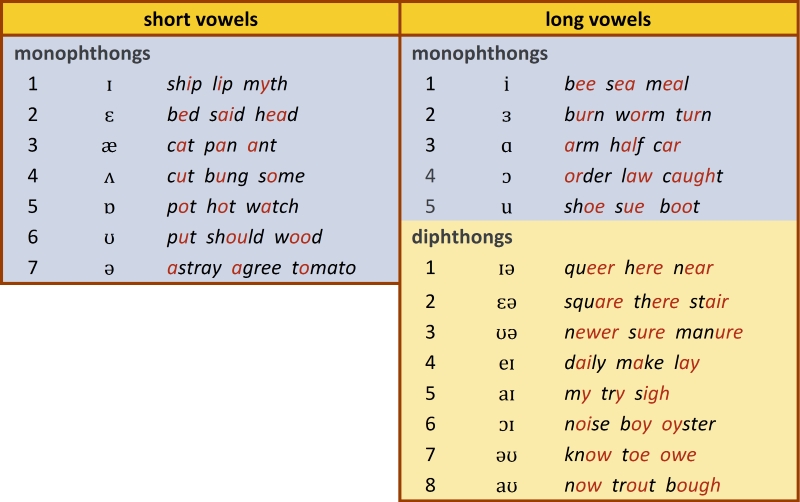
- Fun with Songs
Learning the different vowel sounds can be more fun with songs. They are one of the best ways to teach short and long vowel sounds, as their catchy rhythms can help kids learn vowel sounds and remember them easily. Check out Kutuki’s ‘Short and Long Vowel Song’ . This song is great for kids learning short and long vowel sounds.
For more such fun and engaging songs, download the Kutuki kids learning app now!
- Use hand motions or movements
Use simple gestures for every vowel. This can help kids associate the vowels with the motions and the sound they are making. In addition to working on their muscle memory, the kinesthetic activity makes learning more engaging for kids. For instance, have your child bend their knees when they hear a short vowel sound. For a long vowel sound, ask them to jump up and clap.
- Mark the vowels
It is useful to place a mark on top of the vowels. It indicates the vowel sound to be used. For instance, a short vowel sound is indicated by a curved symbol above the vowel-like ‘ă’ in ‘măn’. While a long vowel sound is represented by a small horizontal line above it, like ‘ā’ in ‘māin’. Such symbols will reinforce your kid’s ability to recognize and use the appropriate vowel sound effectively.
It indicates the vowel sound to be used. For instance, a short vowel sound is indicated by a curved symbol above the vowel-like ‘ă’ in ‘măn’. While a long vowel sound is represented by a small horizontal line above it, like ‘ā’ in ‘māin’. Such symbols will reinforce your kid’s ability to recognize and use the appropriate vowel sound effectively.
- Create Practice Sheets
Have your child practice the short and long vowel sounds using activity sheets. These help kids recognize, understand, and distinguish words with a long vowel sound from those with a short vowel sound.
Please Note: These worksheets are subject to copyright. They are exclusively available only for students enrolled in Kutuki’s Phonics Program.
Kutuki’s Live Phonics Program has an extensive collection of such worksheets. For instance, one such activity has kids circle given pictures that match the vowel sound. While another, have them add magic ‘e’ to the given word and match the word with the right image.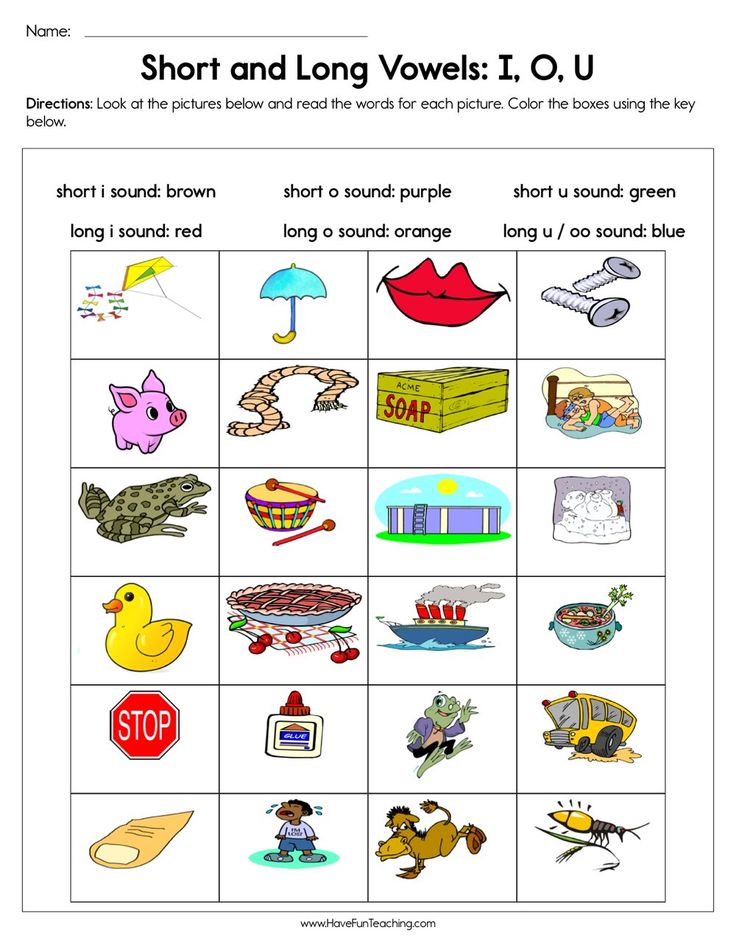
These are just a few activities to help you get started with short and long vowel sounds for preschoolers. If your child is struggling to learn vowel sounds, do not stress or overwhelm the child about it. Remember, every child learns at their own pace!
If you are looking for expert guidance on phonics for your child, enroll in Kutuki’s Live Phonics Program today. 1000s of students have become active readers. Your child could too! The Kutuki kids learning app offers interactive stories, engaging rhymes, and games with attractive animations and illustrations to meet the learning needs of preschoolers
Rules for Long and Short Vowels
SOLACE POWELL
VOCAB
In the classroom, students learn a large number of vocabulary words. Because it is impossible to teach anyone to properly pronounce and spell every word they will use, teaching them the basic phonic sounds are important. Learning to recognize the sounds constants and vowels makes is especially important in reading and learning to spell.
Explore this article
- Long Vowel Sounds
- Short Vowel Sounds
- Long and Short Vowel Sounds
- Irregular Vowels
1 Long Vowel Sounds
A long vowel is a vowel that says its name. Some words or syllables that end in a vowels, such as hi, knee, no and she, sound like their name. There are exceptions to every rule, and "do" and "to" are two exceptions to this rule. When followed by at least two constants, the vowels "i" and "o" have the long vowel sound. Example words are child, hold, post and kind.
Two vowels side by side in the same word says the name of the first vowel. The second vowel is silent. Some example words are gate, made, seal, teen, mile, rise, spoke, flow, use and mule.
Vocabulary Builder
2 Short Vowel Sounds
A short vowel is identified in two ways. The vowel is usually the only vowel in the word and the vowel is between two constants.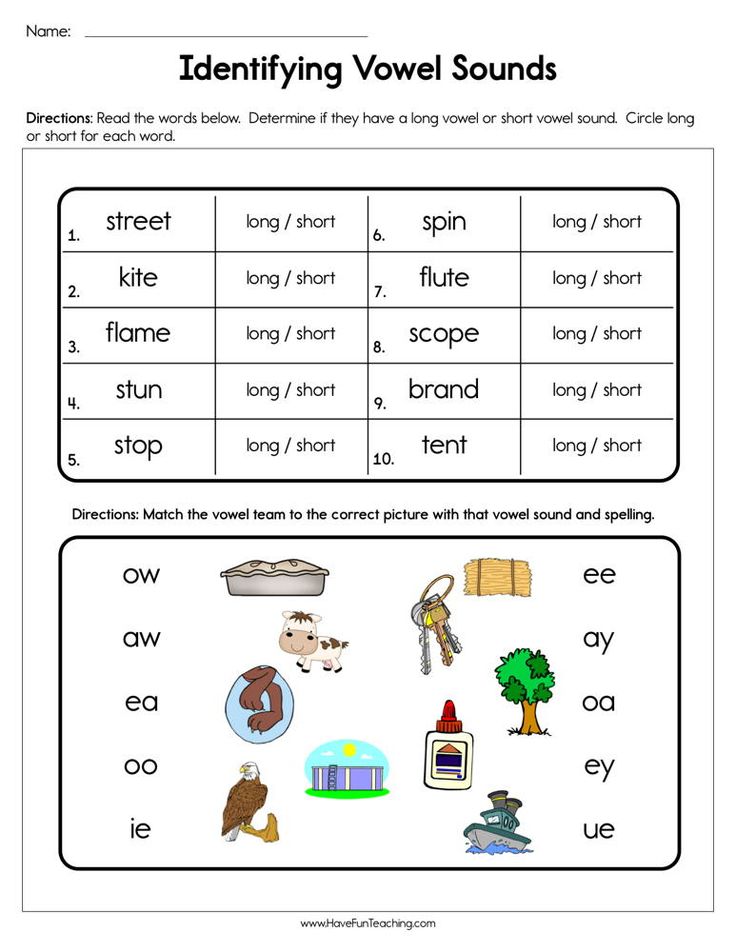 Sometimes the vowel begins the words. Some example words include: ant, van, egg, bed, pill, rib, God, pot, cup and pump. Words ending in "ck" usually make the short vowel sound. Words such as black, knock, thick and pluck.
Sometimes the vowel begins the words. Some example words include: ant, van, egg, bed, pill, rib, God, pot, cup and pump. Words ending in "ck" usually make the short vowel sound. Words such as black, knock, thick and pluck.
3 Long and Short Vowel Sounds
The double "o" combination has both short and long vowel sounds. The sound depends on the word. In "book" and "took," the double "o" has a short sound. In boo, food and smooth, the double "o" has a long vowel sound. The double "o" homophone is easily mistaken with the "ou," "ui," "ue," and "ew" combinations, which makes the same sound. Example words are soup, fruit, ruler, blue and screw.
4 Irregular Vowels
Certain vowels do not follow the rule for long and short vowels. For example, when the vowel "o" is followed by "i," the two-vowel rule is not followed, as in "boil." Ending the "io" combination with an "n," and beginning the combination with an "s", "t" or "c" changes the pronunciation to "shun. " An "e" that is followed by a "d" makes one of three sounds. Example words are: lifted, played and walked. The rules of long and short vowels does not apply to words ending in "igh," such as thigh, light, high, and sigh. Because the combination "ough" makes at least seven different sounds, it falls under irregular verbs. The different sounds are heard in the following words: bough, cough, hough, tough, through, thought and through.
" An "e" that is followed by a "d" makes one of three sounds. Example words are: lifted, played and walked. The rules of long and short vowels does not apply to words ending in "igh," such as thigh, light, high, and sigh. Because the combination "ough" makes at least seven different sounds, it falls under irregular verbs. The different sounds are heard in the following words: bough, cough, hough, tough, through, thought and through.
references
- 1 SpellZone: Unit 13H: Homophones for Unit 13
About the Author
Solace Powell began professionally writing in 1998. Her articles have appeared in "The Comet," "The Mace and Crown" and "The Courier." Powell received her Bachelor of Science in engineering from Old Dominion University.
Related Articles
Long Vowel Sound Rules
What Are VCCCV Pattern Words?
List of Onset-Rime Phonics
Singular and Plural Rules
The Meaning of the Om Symbol
How to Divide English Words Into Syllables
Difference Between Long Vowels and Short Vowels in.
 ..
.. What Are Phonemic Awareness Activities in 3rd Grade?
Rules of Consonant Blends
How to Learn Phonics for Adults
How to Say "Beautiful" in Japanese
Rules for Short Vowel Sounds
How to Use Nauseated and Nauseous Correctly
Proper Use of Apostrophes
How to Use Apostrophes in Contractions, Possessive...
How to Teach Phonics Using Ba, Be, Bi, Bo, Bu Sounds
How to Alphabetize Names With Hyphens
What Does Witch Hazel Do to the Face During a Facial...
How to Clean an Amethyst Ring
What Is the Difference Between an Open & a Closed Syllable?
Long and short vowels in German: long and short sounds
Photo: suju / pixabay.com
So, voiceless and voiced consonants can form pairs. What about vowels? Of course, vowels cannot be voiceless or voiced, but they can be pronounced long or short and form pairs in longitude.
Let's see how it works in German!
What are long and short vowels for?
In modern Russian and most Slavic languages, all vowels are pronounced short, and their lengthening may seem strange or even funny to us (for example, in Finnish or Estonian).
Long and short vowels are common in German and English. Their sound is not as noticeable as in the languages from the example above, but it is extremely important in conversation and perception of oral speech. The thing is that two words that are completely different in meaning can differ in a single, long or briefly pronounced letter.
For example:
Long and short vowels in German: basic rules
There are a whole bunch of rules on this topic that have one thing in common: it seems incredible to fit them in your head and apply them. Let's try to figure it out so that you remember most of it the first time!
Long and short vowels in stressed and unstressed syllables
Stress/unstress can be used as a basic rule for determining vowel length. Stressed vowels are usually long, unstressed - short. This dependency seems perfect! In fact both long and short vowels can be stressed or unstressed. When determining the length of a vowel, not only the stress is important, but also the openness/closedness of the syllable.
Stressed vowels are usually long, unstressed - short. This dependency seems perfect! In fact both long and short vowels can be stressed or unstressed. When determining the length of a vowel, not only the stress is important, but also the openness/closedness of the syllable.
Long and short vowels in open and closed syllables
Depending on what letter the syllable ends in, it can be classified into one of three categories:
- Open - end in a vowel (Ma | ma, Pa | pa) open" when changing the form of the word, for example in the plural (Bal | kon - Bal | ko | ne)
- Closed - end in a consonant (Klas | se, Mund)
Vowels in open and conditionally closed syllables are usually long . In closed - short. To sum up:
- Stressed vowels in open and closed syllables are long, and unstressed vowels are short.
- Vowels in closed syllables, regardless of stress, are short.
Long vowels in German: when?
In order not to bother with special cases, let's take the rules with the "maximum guarantee".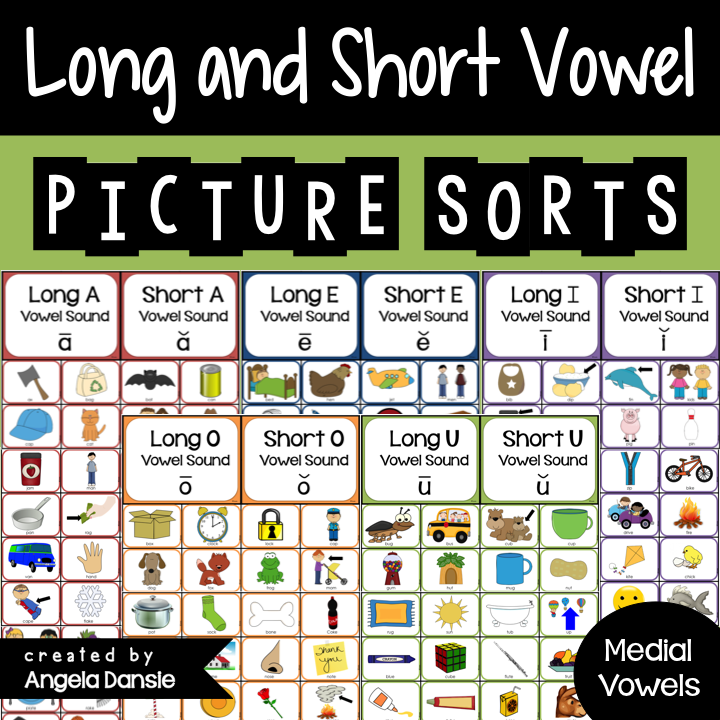 German vowels are always long:
German vowels are always long:
- When they are doubled: -aa-, -ee-, -oo- (-uu- and -ii- are rare, usually in compound words, double umlauts do not occur at all)
- Before “mute “H” (such an “H” is not pronounced, but only gives a long vowel)
- Before ß
- In letter combinations -ie-, -ieh-
- In monosyllabic, invariable words ending in “R”
- Stressed open syllable
- Stressed closed syllable
Good news! 4 rules out of 7 are easy to recognize in the text, and the rest after a little training will begin to be used intuitively.
Let's look at examples of how and when long German vowels are pronounced. In the table below, for each word, two Russian transcriptions will be given: correct and incorrect. Having said both, you can in practice compare the sound of words and feel in what situations a long vowel occurs.
Short vowels in German: when?
Long vowels are clear, let's move on to short ones.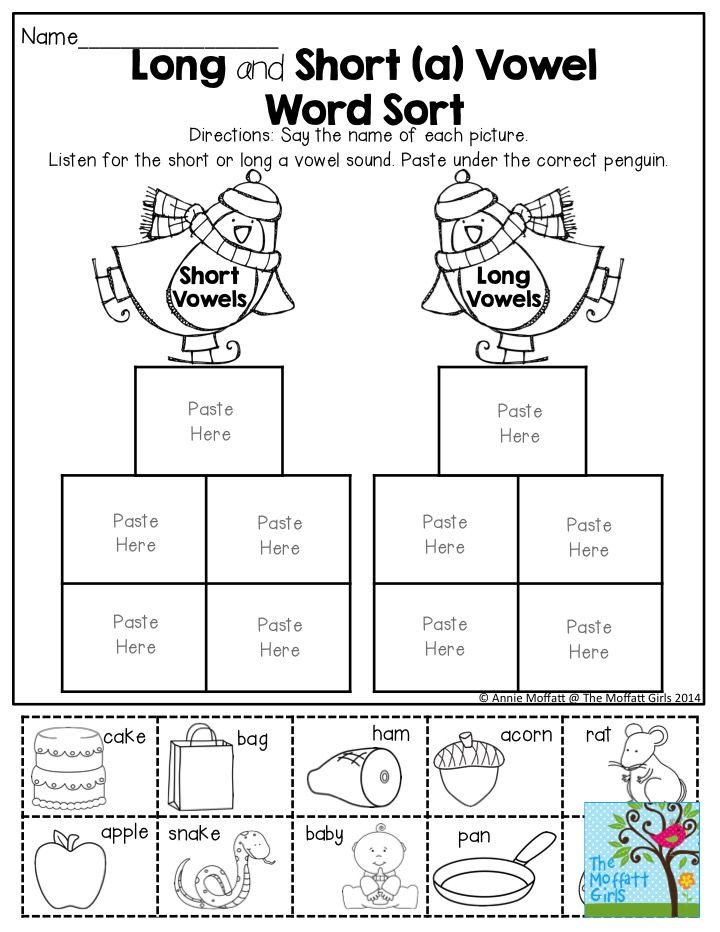 There are only three basic rules at work here. German vowels are read briefly:
There are only three basic rules at work here. German vowels are read briefly:
- In a closed syllable
- If they are followed by two or more consonants (that is, before letter combinations like -ch-, -sch-, -ck-, doubled and any other consonants that follow each other after another)
- Before the letter “X” - [x] (since “X” is read as [ks], formally this rule can be attributed to the previous one)
Consider short vowels with examples. As in the previous table, each word has one correct and one incorrect transcription.
Long and short vowels in monosyllabic words - a controversial case
In addition to monosyllabic words ending in "R" (with long vowels), there are many other short words in German in which only one consonant follows a vowel. It can be articles, adjectives, nouns and other parts of speech. For example: dem, gut, Lid, Typ.
On the one hand, these are closed syllables, which means that the vowels in them are short. But it's not! There is no need to memorize anything here, you just need to understand that in such words both short and long vowel sounds can occur.
But it's not! There is no need to memorize anything here, you just need to understand that in such words both short and long vowel sounds can occur.
How to pronounce long and short vowels?
There is no secret here! Long vowels are pronounced longer than short vowels. That's why "you're not speaking correctly because my [a:] is longer than yours" doesn't work here.😎
The pronunciation of long and short vowels depends entirely on the speech apparatus, accent, dialect used, and other little things. Someone likes to "pull" sounds and even short letters sound like long ones. Someone pronounces short vowels so abruptly that long vowels sound like ordinary ones.
In general, as you like. The most important thing is that the difference between long and short sounds can be heard in speech.
Conclusions
Vowel length and shortness are very important in German. At the same time, there are no special pronunciation rules , it is only important to understand the difference between long and short sounds and be able to convey and understand it in oral speech.
You don't have to memorize a lot of conditions and exceptions. Enough to try to remember the basic rules and follow the pronunciation. Automatic speech will come later , on its own.
And in order to digest the new information and test yourself, we offer you to take a small online test: "Practical task: long and short vowels in German."
Sources:
Audio representation of letters - Wiktionary
Long and short vowels in German
Wie geht’s, Leute? With you again Christoph. Well, I hope people still read me who saw where my blog started, because today we decided to return to one of our old topics. You guessed it, this topic is German pronunciation and how to achieve the perfect German accent. Increasingly, people are enrolling in our classes who complain that they have been living in Germany for a long time, but nevertheless experience difficulties in communicating with the locals. When I begin to communicate with these people myself, I find that, as a rule, in terms of grammar and vocabulary, their German is almost flawless.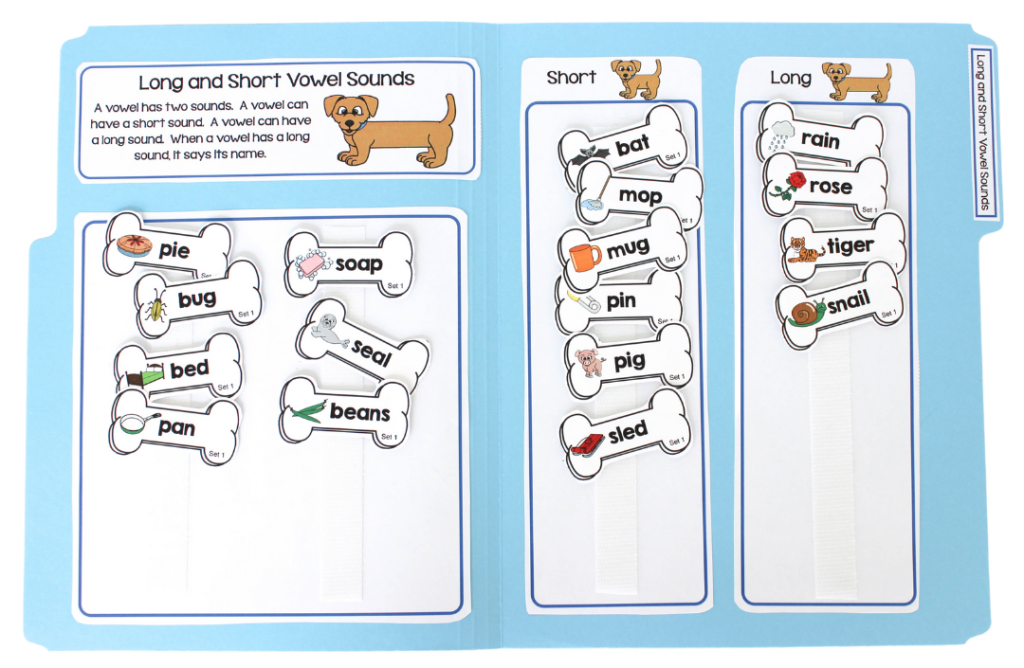 But in terms of pronunciation - not always.
But in terms of pronunciation - not always.
In this video, I decided to analyze one of the most subtle mistakes in German pronunciation, which, nevertheless, is considered very rude by the Germans. This is the length and shortness of the pronunciation of vowels. How do they differ and why is it so important to be able to pronounce them correctly? This is what today's article will be about. But before starting, be sure to watch our video, where we sort out in practice the difference between long and short vowels in German.
So, as you understand, the length and brevity of pronunciation is one of the features of the pronunciation of German vowels. Simply put, almost all German vowels exist in two versions: long and short. Why is this needed? Well, it's simple. The fact is that depending on the brevity or length of the sound, you can completely change the meaning of the German word. Don't believe? Here are some real life examples for you. If in the phrase Mühlbergstraße the combination üh is pronounced short, and not long, then instead of Mühl (Russian mill), you get Müll (Russian garbage). Would you like to live on the street on a garbage mountain? That's what I wouldn't want!
Would you like to live on the street on a garbage mountain? That's what I wouldn't want!
As you can see, on the example of a simple everyday situation, by changing the length of the sound, we get completely different words and a complete misunderstanding on the part of the Germans! In Russian, vowels do not differ in length and shortness, therefore, in place of long vowels, Russians, as a rule, use the usual short versions of these sounds. This leads not only to an accent, but sometimes to complete embarrassment.
Well, sort of, we figured out the theory. Now let's go through the main pairs of long and short vowels and analyze their correct pronunciation.
Free German lesson
Want to learn German but don't know where to start? Sign up for a free trial lesson at our center and discover the fascinating world of German with native German speakers!
German vowels [ɔ] and [o:]
The first pair is short and long “o”. First, let's deal with the short version, because it is more or less similar to Russian.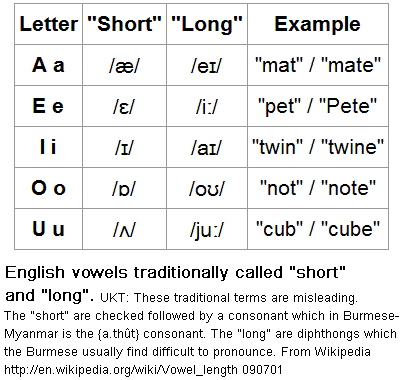 To pronounce the sound [ɔ], you need:
To pronounce the sound [ɔ], you need:
- round and tighten the lips,
- move the tongue back a little,
- lower the lower jaw slightly.
Examples : der Onkel, voll, hoffen.
The long version of this sound differs from the short one in that when it is pronounced, the lips are more advanced and slightly relaxed. In addition to open syllables, the long “o” is also pronounced in combinations such as oh and oo.
Examples : der Hof, wohl, das Boot.
The long version of this sound differs from the short one in that when it is pronounced, the lips are more pushed forward and slightly relaxed. In addition to open syllables, the long “o” is also pronounced in combinations such as oh and oo.
Examples : der Hof, wohl, das Boot.
German vowels [ɛ] and [ɛ:]
These sounds are somewhat reminiscent of the Russian sound “e”, but still have some differences in articulation.